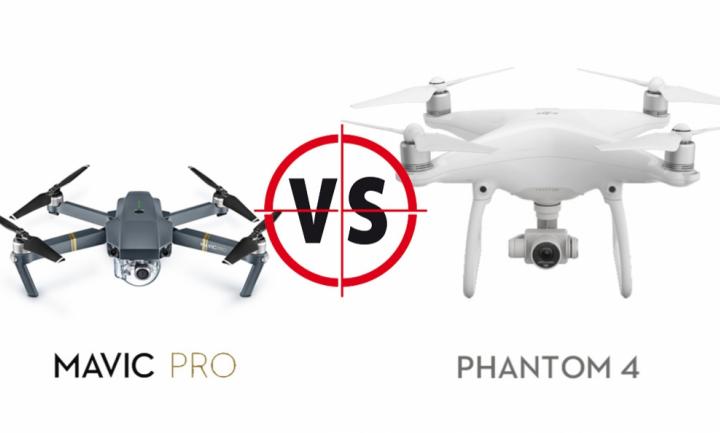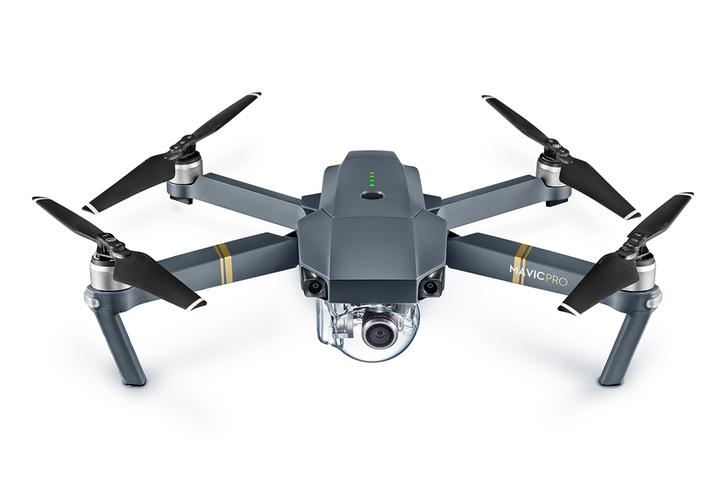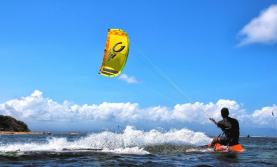DJI Mavic Pro Vs. DJI Phantom 4
Image

DJI is the leading manufacturer of drones and quadcopters in the industry and set a standard for drones. With their advanced technology and strive for adding cool and new features with every release, they now have a wide range of quadcopters to choose from.
There is a lot of comparison between the DJI Mavic Pro vs. GoPro Karma, but ever wondered which out of the DJI drones would make the better drone for you to buy?
Two of their newest releases, the DJI Mavic Pro and the DJI Phantom 4 both have garnered a lot of praise from consumers and drone fans due to their top class flying features. Here’s a comparison of the two drones and their specks to see which drone can suit you better.
Design
When it comes to the design of the Mavic Pro, DJI has taken all their expertise of creating spectacular unmanned aerial vehicles, and applied that knowledge into a compact, sleek and foldable body. The DJI Mavic Pro drone was created with portability in mind, and with its foldable design the drone becomes as small as a water bottle with the arms and propellers safely tucked inside.
Users can simply toss the drone into their bag and not have to worry about detaching the props beforehand. Other elements like the camera and gimbal too are protected, as they have a transparent cone surrounding it, so damage to the structure or lens will not be incurred.

On the other hand, the DJI Phantom 4 focuses more on a design that highlights its aerodynamic lines. The frame has a lightweight composite core for added stability and agility while flying, and the core also has a remodeled gimbal that has now been positioned for a better center of gravity and to lessen the risk of propellers coming in the recordings and pictures.
In comparison, the Phantom 4 does lack foldability and as much portability as the Mavic Pro because you need a special case for it and it can’t be folded easily into a compact size. Another disadvantage is that the propellers on the Phantom 4 need to be attached and detached every time, where as the Mavic Pro just folds the props into its portable design without exposing them to any damage.
Camera
The Mavic Pro uses a 3-axis gimbal that provides shake-free footage and pictures when recording in the air, and it is also the smallest gimbal the company has built till now. It features a camera that can record in 4K at 30 fps, as well as 1080p HD at 96 fps. It features a minimum focusing distance of 19 in (0.5 m), which is a great improvement over the previous DJI drones and DJI Osmo.
The camera can take pictures in 12MP and the picture can also be flipped 90 degrees to a portrait mode for taking vertical photos.
The DJI Phantom 4 also uses a 3-axis gimbal and the aerial-optimized 4K imaging device has enhanced optics for improved corner sharpness and decreased chromatic aberration. Equipped with a 12MP sensor and F2.8 lens, this quadcopter can shoot Raw stills and take videos in 4K/UHD at 30p as well as 1080P 120/60/30 fps.
On the face of it, both the drone are quite similar when it comes to camera features and come with a 3-axis gimbal as well as provide 4k recording at 30fps. But the Phantom 4 has a slightly higher fps at 120fps for 1080p recoding than the Mavic pro that maxes out at 96 fps. Despite of this difference, many drone reviewers still claim that the Mavic Pro can provide better video quality with color and the dynamic range.
Flight features
The DJI Mavic Pro has special awareness features like obstacle avoidance and Flight Autonomy guidance system. Obstacle avoidance combined with sensor redundancy increases the flight’s safety and consistency, and the drone is capable of avoiding an obstacle from as far away as 49 ft. (15m). Flight Autonomy also means that the drone can hover more precisely, and can also automatically land back to where it took off.
The drone has an Active Track mode that lets you shoot like a pro and makes the drone track the person you tell it to. In this mode, the drone can ‘Trace’ the subject by following behind, leading in the front, or circling around it, it can ‘Profile’ the subject by flying along it, or ‘Spotlight’ by focusing only on the subject while you fly it around.
With the Gesture Mode, you can conveniently take a selfie by making a particular gesture when the drone is pointing at you, while the Tripod Mode makes the drone fly slower to just 2.2 mph (3.6 km/h) for easier flying indoors. Another new addition is the Terrain Follow Mode, where the Mavic Pro keeps a level height from the ground, between 1 ft. (0.3 m) to 33 ft. (10 m), allowing it to not fly too close to the ground.
On the other hand, the DJI Phantom 4 uses highly advanced computer vision and sensing technology that makes professional aerial imaging much simpler and advanced. It includes new on-board intelligence that make using the drone and its features like Obstacle Sensing System, ActiveTrack and TapFly.
The Phantom 4 uses an Obstacle Sensing System that has 2 forward-facing optical sensors for scanning obstacles and automatically moves the drone around the obstruction, leaving little room for collision and keeping the flight direction constant.
With its ActiveTrack feature, the Phantom 4 can track and ensure the camera stays centered on a particular subject as it moves, by just ‘tapping’ the subject on their mobile or tablet screen. TapFly allows fliers to double-tap a particular destination on the mobile or tablet, and the quadcopter will estimate the best flight route to get here, all while avoiding any obstacles. By tapping again on another spot, the drone will smoothly change over to the new destination.
DJI has already pointed out that they created the Mavic Pro based on its predecessor Phantom 4’s features and has bettered them while adding a few new ones as well. Forward-facing obstacle avoidance, downward-facing sensors, and active tracking have all been upgraded so the Mavic Pro can even recognize which mode of transport the subject is using.
Mavic Pro’s flexibility and versatility extends to providing fliers with precision positioning and easier indoor flying as well. Both drones have a ‘Sport’ mode, but only the Mavic Pro is compatible with DJI’s new FPV goggles, which provide a more immersive experience.
Battery and power
The Mavic Pro drone uses an Intelligent Flight Battery that is safer and easier to use than regular ones. It provides a flight time of around 27 minutes when flying at speeds of up to 40mph (64kmh), which is actually longer than the flight time that the new GoPro Karma Drone boasts.
For the Phantom 4, DJI made modifications to the motor’s efficiency, power management and added a new intelligent battery to provide an extended flight time of up to 28 minutes.
The flight time of both the drone is about the same at 27-28 minutes, however when we talk about power the have slight differences. Both the DJI drones feature a Sport mode and the Phantom 4 can reach 44mph, which is 4mph more than the Mavic Pro. The Phantom 4 is also bulkier in comparison, so it is able to deal with slightly higher wind speeds better.
Conclusion
The DJI Mavic Pro is the newest release by the leading drone manufacturers, and is a compact yet powerful drone, created to meet the consumers’ needs. Even though it has a small size, it possesses features as powerful as the DJI Phantom 4, if not better.
The Mavic Pro does possess better features than the Phantom 4 and provides convenience in many areas the latter doesn’t. The Mavic Pro pricing starts at just $999 while the Phantom 4 starts at $1,199.
Logically it makes more sense to buy a newer model that comes with upgraded features plus new ones, and specially since it costs lesser than the older model. The portability adds another big factor to this decision.





